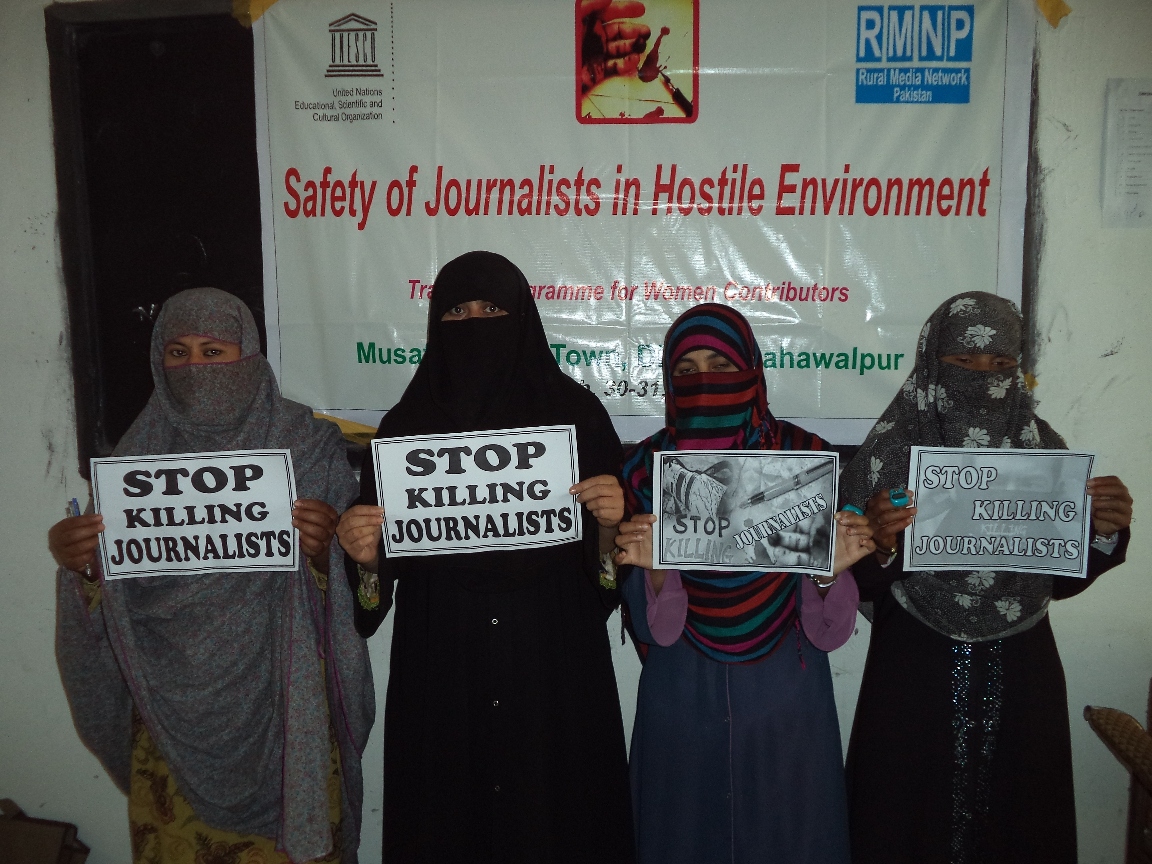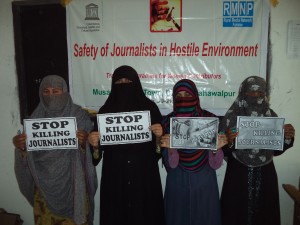One Hundred Twenty Five Journalists Attend Series of Six Safety Training Workshops in South Punjab, Pakistan October 2014 to March 2015

125 media professionals including 38 women contributors working in rural areas of Pakistan benefitted from a training programme which equipped them with the necessary safety skills and knowledge to report in hostile environments.
The project, which was implemented by the Rural Media Network of Pakistan (RMNP), kicked off with a workshop held in Tehsil Yazman, District Bahawalpur, on 18 and 19 October 2014 and concluded in Musafir Khana area of South Punjab on 31st March 2015. Six training workshops were organized in Bahawalpur. MuzzaffarGarh and RahimYarKhan districts of South Punjab.
All six events were conducted by Karachi- and Lahore-based trainers, and were attended by 125 rural journalists including 38 women contributors.
116 journalists have been killed in Pakistan since 2000 while In 2014,sixteen Pakistani journalists and media workers lost their lives .International federation of Journalists (IFJ) has again declared Pakistan’ most dangerous country for media. As per RMNP monitoring 2014 remained tough for the journalists as more than one dozen of them were killed in different terror related and sponsored violence while scores others received threat calls and intimidation letters. Media houses were attacked and media persons performing filed duty thrashed by the police and the political activists.
The biggest challenge apart from direct threat to the life of journalists is in Pakistan is a culture of impunity. The killers of two journalists out of 116 have been arrested during last decade. This promoted impunity and allowed any one to threaten and target journalists because they know they can get away with murder. In 2014, two journalists were shot dead in Hafizabad district of Punjab province within three days time, said President RMNP Ehsan Ahmed Khan Sehar while addressing the certificate giving ceremony of women contributors safety training workshop in MusafirKhana area of South Punjab.
To cope with this alarming situation UNESCO backed ” Safety of Journalists Working in Hostile Environment in Rural Pakistan” aimed to increase the safety of journalists working in hostile environment through training. All six training programmes were organized in three districts MuzzaffarGarh, Bahawalpur and RahimYarKhan of South Punjab which is the grip of religious extremism and sectarian violence. A total 90 journalists were scheduled for six training workshops but due to pressing demand 125 journalists learnt safety techniques. RMNP upgraded training manual on safety issues published in country’s language Urdu was a part of safety mechanism of this project. Participants complained that religious extremists force them to cover their speeches and pressurize them to publish their news word by word..
.This IPDC/UNESCO project established safety mechanism for journalism practitioners in three extremists and feudal dominated areas of South Punjab as no media house in Pakistan is providing training facilities despite the alarming situation for working journalists. UNESCO backed project also expanding press freedom network which has renewed its call to Pakistani government to make the protection of journalists its priority.
“We hail the decision to include 38 female contributors in Samasatta and MusafirKhana training workshops, said RMNP Coordinator Ms NajmaunNisa Bukhari, she added that in the rural areas of Pakistan, where 70 percent of country inhabitants live, only few journalists are female, and often without much authority. In Bahawalpur region a home of 12.5 million not even a single female journalist is present. Rural societies in Pakistan are highly segregated and in the grip of religious powers. Men cannot report about women’s issues due to cultural barriers: they cannot approach and talk with women freely. So the almost none-existence of women journalists means that the media does not cover a large segment of rural life. Women’s’ perspective is missing in the news coverage. There is an urgent need to expose human rights violations against women in local and national media. Therefore we hope that the 38 female beneficiaries will be helpful to remedy the glaring absence of women among thousands of district correspondents, get into the field and write about women’s issues, which in the past have been left uncovered by men.
Training was imparted as per schedule prepared one week before the workshop at each place. It included relevant topics for reporters and correspondents attached with electronic and print media. Generally it was comprised of lectures about safety issues as:
Working in Hostile Areas;
The Real Threats;
How to Cover Violent Mobs;
Pressures, Threats and Intimidation from Different Sources
Contacts and Relations with Sources;
How to protect Facts and Maintain Balance in Your Story; and
How to Cover a Bomb Blast.
But the schedule was made flexible in light of mutual discussions and issues like feudal lords atrocities, gang rapes and honor killings were also included according to the requirement in different workshops. Practical exercises were also conducted to improve their writing skills.
The workshops also discussed how media can monitor attacks on press freedom, and support journalists who have been victims of such attacks. Participants discussed the importance of monitoring freedom of expression and were provided with practical guidelines for this. The training programme ended with the setting up o six five-member press freedom monitoring committees in Yaman,Jatoi,Khanpur,Liaquatpur,Samasatta and MusafirKhana areas of South Punjab.Women contributors who attended SamaSatta and MusafirKhana training workshops adopted following recommendations.
.
Recommendations
Women journalists should be encouraged to discuss their particular needs for support and protection with their colleagues – male and female – and ensure that these are met.
Colleagues and managers should be aware of the unnecessary pressure women can experience to prove that they are capable of doing the job.
It must be made explicitly clear to everyone that sexual harassment and sexual advances are unacceptable. Male bosses should be aware of and acknowledge the threat and fear of rape.
If working as an embedded reporter, don’t assume anything in terms of your personal safety. Do all you can to be clear in advance about the conditions you will face.
If possible, women journalists should be allowed a say in who they would like to work with in a team.
Women journalists (including freelancers) should also, if possible have the opportunity to train in self-defense.
Hostile environment training courses should directly address women’s needs – which will in turn help raise awareness among their male colleagues.
Women need smaller and properly-fitted body armour which they can wear comfortably.
Colleagues – male as well females – should take the initiative to ask women they are working with if they need more feminine supplies.
Before any assignment, female employees and their managers should make sure they know of any local customs specific to women.

